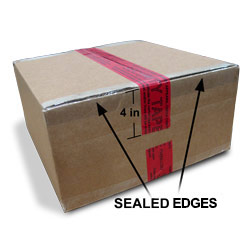
Security Tape Troubleshooting Guide
Click the links in the table of contents below to take you to that section of the page:
Table of Contents
- Why does the hidden VOID message appear when I unwind the tape?
- How quickly will the tamper evident feature be functional?
- The tape can be removed cleanly and it does not show the tamper evident message (OPENED). What's the problem?
- When the tape is removed, it tears fibers from the surface and the tamper evident message (OPENED) does not appear. What's the cause?
- What is the difference between a paperboard box and corrugated cardboard?
- Does the corrugated carton or paperboard box have a marking to indicate the surface strength?
- Do we need a special tape for the corrugated cartons we use in our freezer?
- The tape is being applied to stretch wrap film. When removed, the film tears. How do we eliminate tearing the film?
- The security tape is being applied on top of other tape which is on the carton, but the security tape is not adhering. What is the problem?
- What is the shelf life of the tamper evident tape ?
- Why does the security tape pop loose on the sides and not tamper after sealing the shipping carton?
- One side of the roll of tape is bulging out -- what is the problem?
Unwind the tape slowly. Dispensing the tape too quickly (faster than 12 inches/second) from the roll may prematurely reveal the hidden VOID/OPENED text. However, if the problem persists even when unwinding slowly, please contact us.
For the recommended surfaces and an application temperature of 70F (or higher), the tape will show tamper evidence (OPENED) after being applied to the surface for these typical intervals:
Premium Tape (PVT/EVT): .............................within 1 minute
Standard Tape (PST/EST or PFT/EVT): .............within 1 minute
Economy Tape: ............................................within 30 minutes
Application at temperatures less than 70F may require more cure time on the surface.
3) The tape can be removed cleanly and it does not show the tamper evident message (OPENED). What's the problem?
Let's work through the checklist.....
- Confirm the surface is on the "RECOMMENDED SURFACES" list for the tape you purchased.
- When applied, the surface temperature must meet the stated MINIMUM APPLICATION temperature. To confirm if temperature is an issue, temporarily move to a location where the surface will be at a minimum temperature of +70F and test again.
- The surface must be dry. Moisture of any kind can cause the problem. Dry thoroughly and repeat the test.
- The surface must be clean. Wipe with a clean cloth or paper towel to remove dust or other loose particles, then repeat the test.
- If there are possible chemical contaminants (oil, lubricants, release agents, etc), clean the surface with 90% Isopropyl Alcohol. Wipe the alcohol dry with clean dry cloth or paper towel, then repeat the test.
- If the surface has a clear coat or clear varnish, confirm if the varnish is still present after the tape is removed. It is possible for the tape to remove the clear coat if it is not bonded well to the underlying surface. If the varnish was removed, we recommend testing our non-residue labels/tape, which feature a less aggressive adhesive.
- The surface may require a longer cure time. Smooth surfaces usually require the shortest cure time. Rough and textured surfaces usually require more cure time. Plastic and powder coated paint usually require more cure time. Apply again and allow the tape to cure up to 4 hours. Longer curing (beyond 4 hours) only marginally improves performance.
- Do not apply the security tape in two or more layers. Only the tape in direct contact with the surface will show tamper evidence. Security tape (and other tapes) have a silicone coating on the top, which may interefere with the tamper evident feature of additional tape layers.
- A "full adhesive transfer" tape is more likely to show tamper evidence on difficult surfaces. We suggest you test the Premium tape (PVT/EVT series) and the Standard Tapes (EFT/PVT).
If you cannot identify the problem from the above steps, the tape selected will not meet your needs. Please contact us for next steps.
4) When the tape is removed, it tears fibers from ('scalps') the surface and the tamper evident message (OPENED) does not appear. What's the cause?
Tearing fibers can be an issue for materials with low surface strength -- usually paper, paperboard, and recycled corrugated cardboard.
Some applications will accept torn fibers as an indication of tampering, particularly if the torn surface has printed text or graphics, which makes the tampering more prominent. However, ideally when security tape is removed from the original surface, there will be a clear tamper evident message on the surface and in the tape and no scalped (delaminated) surface.
Delaminating the box surface is an indication of lower strength in the carton surface compared to the 'breakaway' level of the tamper evident message (OPENED) in the tape.
Absorbed moisture in the corrugated material can be a contributing factor because it reduces the carton's surface strength. Store cartons in a controlled area to keep them dry.
Often, the culprit for paper-type products is high recycled content, which usually has a lower surface strength compared to virgin content. So one option is to change to packaging materials with a higher strength - those formulated with higher virgin content.
Another possible cause is the surface construction. Short fibers or low binder levels in the corrugated material can reduce the surface strength. Again, to eliminate this cause requires a change in the materials.
Look for markings on the box which indicate the strength of the carton surface. For example, a carton marked ONLY as "ECT 32" (which refers to Edge Crush Test) is generally an economy grade box. Cartons marked "200 lb" and "275 lb" (which refers to burst strength) usually have higher strength surfaces which are not prone to delamination.
If delaminating the carton surface is an issue, our 'full adhesive transfer' tapes (PVT/EVT, PFT,EFT or RC series) have the highest probability of success because the "breakaway" level of the hidden message is lower compared to our standard tapes.
Here are typical examples of each:
- Most shipping cartons are constructed of corrugated cardboard. A cross section of the corrugated cardboard shows a wavy middle (fluted) section sandwiched between two flat sheets (liners). Most shipping cartons are a kraft brown color, but some are clay-coated which provides a glossy finish (like the outer surface of a FedEx box).
- Paperboard is a single flat piece of material -- usually .010 to .030 inches thick. Typical examples of paperboard are a Fedex envelope, rigid mailers, pharmacuetical box, etc.
Regarding compatibility, most of our security tapes work equally well on both paperboard and corrugated cardboard. However, we provide free samples so you can test and confirm the product suitability before ordering.
6) Does the corrugated carton or paperboard box have a marking which indicates the surface strength?
Currently, there are no markings to indicate surface strength, which is a key parameter to avoid tearing fibers (scalping the surface).
Most shipping cartons include a printed information on the box bottom which indicates structural capabilities, such as:
- Edge Crush Test, which pertains to the stacking height of boxes (ie,the compressive strength of the box).
- Size Limit, which pertains to the maximum dimensional length of the box (ie, the bending strength of the box).
- Gross Weight, which indicates the maximum weight the box can carry (ie, the burst strength of the box).
But none of these characteristics pertain to the cartons's material surface strength.
But it's easy to test for surface strength; just order our free samples, affix to your surface, then remove after 1 minute.
Most of our security tapes perform well on paperboard or corrugated. Our "full adhesive transfer" tapes (PVT/EVT, PFT/EFT and RC series) have the most versatile performance for high recycled content cardboard.
Corrugated cardboard used in refrigerators and freezers may have moisture resistant coatings (wax or other chemicals). Without these coatings, condensation can reduce the structural integrity of the carton. However, these coatings can reduce the bond between the tape and surface. Also, the coatings may reduce the effectiveness of the hidden tamper evident (OPENED) feature.
Our "full adhesive transfer" formula tapes (PVT/EVT, PFT/EFT, and RC serieis) have the highest probabiliy of success on cartons which have a moisture resistant coating.
8) The tape is being applied to stretch wrap film. When removed, the film tears. How do we eliminate tearing the film?
Tearing the pallet film can be an issue for pallet film materials with low strength. Using a thicker stretch wrap film will increase the surface strength and eliminate the problem.
Another option is to use our "full adhesive transfer" tapes (PVT/EVT, PFT/EFT and RC series), which have the highest probability of success on shrink and stretch films.
9) The security tape is being applied on top of other tape on the carton, but the security tape is not adhering. What is the problem?
The problem is probably related to the silicone coating on the underlying tape, which is interfering with the adhesion of the security tape. For the best adhesion, apply the security tape directly to the carton. Our security tape is designed to be used in a single layer to both seal the carton and provide tamper evidence. If the security tape crosses over other tape, extending the top tape layer a few inches to be in direct contact with the carton will insure the tape ends are secured.
One other consideration, from a security perspective, if you apply security tape over existing carton sealing tape, the underlying carton sealing tape could be removed without activating the tamper evident feature of the security tape. In this situation,it is usually better to extend the security tape so at least a portion is in direct contact with the carton. Another option is to remove the carton sealing tape and replace it with security tape.
Recommended storage temperature is 40 to 80F. The maximum temperature prior to application is 100F. When stored under these conditions, we warrant the tape will have a MINIMUM shelf life of 2 years from the date of purchase. Our experience indicates the shelf life can be over 5 years, but we only warrant the tape for 2 years from the invoice date.
In the unlikely event you have a shelf life issue with your tamper evident tape, you will have one of the following conditions:
- If exposed to extreme heat, the adhesive will ooze from the sides of the roll and totally bond the roll -- you will not be able to unwind the tape; it will be a solid plastic cylinder.
- The face of the tape has a silicone coating. If the silicone surface degrades (possibly caused by high temperatures), the tape will tamper as it is unwound from the roll -- it will show the hidden "OPENED" message before it is applied to the carton and it will leave adhesive residue on the underlying tape still on the roll.
- If the bond of the silicone to the film surface degrades (possibly caused by high temperatures), when applied to the intended surface, the tape will not adhere to the intended surface.
The above shelf life issues only occur BEFORE the tape is applied to the box. If you can successfully apply the tape to the intended surface, there is no shelf life issue.
11) Why does the security tape pop loose on the sides and not tamper after sealing the shipping carton?

Photo A

Photo B
Some boxes have excess 'spring' in the flaps (see Photo A), which can be caused by overfilling the shipping carton. Also, thicker corrugated cartons can have excess spring in the flaps. When the flap is closed, the spring causes added stress in the tape affixed to the side of the box, and this continuous pressure can cause the security tape to pop loose from the side of the box. If there is excess pressure from the flaps, usually the tape will pop loose within 6 hours.
This situation can be resolved by using standard carton sealing tape to seal the edges of the top flaps to the side of the box (see Photo B). Or you can use security tape as well. Another, option is to glue or staple the flaps closed before applying the security tape to the center seam.
When the excess spring has been addressed, use the security tape to seal center seam. Extend the tape at least 4 inches down the side of the box. Repeat this process for the bottom of the carton.
We refer to this issue as "coning", where the roll becomes cone-shaped. It can be caused by storing rolls standing up; we recommend storing rolls on their edge. Usually, the roll will return to its original configuration by storing rolls on the edges, as shown below. If storing on the edge does not resolve the issue, please give us a call.

Recommended Storing Method
(Edge of Roll on Flat Surface)

Storing on End Can Cause Coning
(Edge of Roll NOT supported)

Roll with Coning

If Coned, Place Roll in This Position

Coned Roll After 1 week (usually). If not, give us a call.



